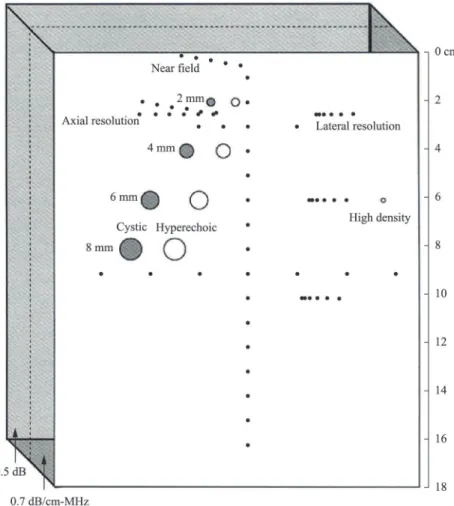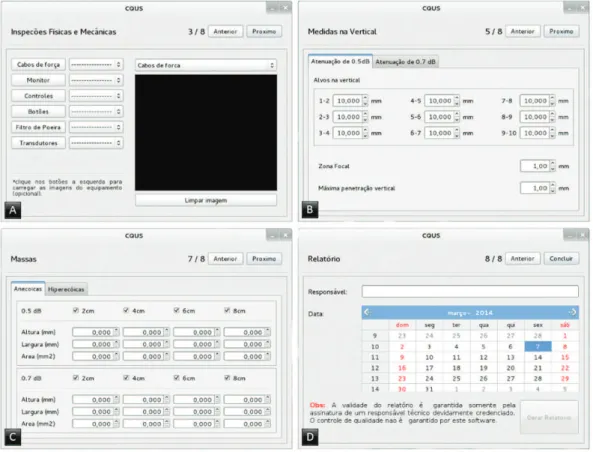Technical Communication
DOI: http://dx.doi.org/10.1590/1517-3151.0644*email: acsenrai lho@usp.br
Received: 19 August 2014 / Accepted: 28 September 2014
A computational tool as support in B-mode ultrasound diagnostic
quality control
Antonio Carlos da Silva Senra Filho*, Erbe Pandini Rodrigues, Jorge Elias Junior, Antonio Adilton Oliveira Carneiro
Abstract Introduction: The quality control (QC) of biomedical equipment is a very important process for the quality
assurance of the instruments used in diagnoses and treatments. Ultrasound diagnostic imaging is one of the most widely used techniques for diagnostic imaging in hospitals and medical clinics. However, the time required to complete several B-mode imaging QC tests in ultrasound equipment is very critical for a hospital with a high number of exams. Here, we present a computational tool to assist in the acquisition and storage of data from multiple QC tests in B-mode ultrasound diagnostic equipment to promote an efi cient alternative for QC in clinical routines. Methods: The project was planned and implemented in C++ programming language and
compiled for two computing platforms: Windows and Linux. The most common QC routine tests for B-mode ultrasound were combined in a simple graphical user interface. Results: After entering all of the correct QC
information in the graphical user interface, a i nal report in PDF format was created. Conclusion: The proposed
program has been helpful for students and diagnostic professionals and is a quick and easy application for several QC tests for B-mode ultrasound diagnostic equipment. Our program seeks to help in the dissemination and application of QC tests for B-mode ultrasound equipment in hospitals and clinics and for the technical training of ultrasound professionals.
Keywords Quality control, Ultrasound, B-mode.
Introduction
In several technology application areas, various quality control (QC) procedures are utilized. Such procedures evaluate the general quality of the equipment used in many clinical procedures, for both diagnoses and treatments. Many diagnostic instruments in radiology and radiotherapy are routinely analyzed and tested by several QC procedures, and maintenance reports are provided to ensure the quality of the instruments.
For diagnostic B-mode ultrasonography, various QC tests have been validated. In general, the applied procedure is adapted from international standards (American..., 1995; Goodsitt et al., 1998; Madsen, 2000; National…, 1988) to maintain the routine practice of QC. In fact, ultrasound instruments are one of the most used and disseminated medical devices in various diagnostic imaging procedures. The application of QC tests for the general maintenance and the proper operation of the equipment is essential.
Several research groups have jointly formulated and implemented QC practices for B-mode ultrasonography in Brazil. Several normative works have been conducted for the international establishment of QC procedures (Alvarenga et al., 2001; British…, 1997; Mühlen, 2001; Oliveira et al., 2010). Even with advances in the i eld, there are still major barriers to their application
in Brazil. Typically, the QC process, including data recording and other paperwork, is performed entirely by hand, which increases the time required for the QC data acquisition and analysis and the susceptibility of human error. Additionally, the lost machine time could be used to diagnose patients, and the generated paperwork presents storage issues for the future analyses of the ultrasound equipment. A few efforts have been made to improve the data acquisition and semi-automatic processing (Alvarenga et al., 2001; Gibson et al., 2001; Mühlen, 2001). However, an efi cient approach to basic QC tests in B-mode ultrasonography is lacking.
In this study, we created a computer system to assist the QC diagnostics of B-mode ultrasonography. The use of computational programs dedicated to the various QC tests is a promising alternative to reducing the required time for the procedures and guarantees the standardization of QC results. Moreover, a semi-automatic QC tool improves the reliability and removes potential bias in data processing due to fewer human inl uences. A more formal and accurate analysis must be performed in our computational system to afi rm these improvements. However, our purpose is to present a computational tool and its functionalities.
B-mode ultrasound quality control
Methods
The project was planned and implemented in C++ programming language and compiled for two common computing platforms: Windows and Linux. The choice of this programming language was made in view of its computational performance and readily available open source libraries for database creation and data analysis.
It is essential that the program implemented current standardized QC protocols. In general, standardized tests follow the international standards (American..., 1995; Goodsitt et al., 1998). Our computational program combined the most common routine QC test applications, as listed in Table 1. All QC tests were performed from a test object (i.e., phantom), and our program was set up, but not limited, to the use of three typical ultrasound B-mode phantoms made recently available (ATS Laboratories, 2012; Computerized…, 2012; Gammex, 2012). Figure 1
shows a typical phantom coniguration. These phantoms are usually known as multipurpose phantoms due to the multiple QC tests that can be performed on only one phantom. There are several different types of ultrasound phantoms with specialized purposes. Here, we used the multipurpose B-mode ultrasound QC phantom.
To increase the availability of the QC procedure, two instruction guide versions are freely provided on
Figure 1. A phantom example developed by CIRS device (Computerized…, 2012). In this phantom, there are several quality control targets, which guide the ultrasound professional through the several quality control procedures listed in Table 1. Every quality control step performed on the phantom has its respective input ield in the software to be illed in with the QC information.
Table 1. Different quality control tests performed in B-mode ultrasound diagnostic equipment. Each procedure is performed in different windows of our software, as observed in Figure 2.
1. Dead Zone 2. Depth
3. Lateral Resolution 4. Axial Resolution 5. Hyperechoic Masses 6. Anechoic Masses 7. Physical Equipment Exam 8. Image Uniformity
Rev. Bras. Eng. Bioméd., v. 30, n. 4, p. 402-405, dez. 2014
Senra Filho ACS, Rodrigues EP, Elias Junior J, Carneiro AAO
the software website1: one is in A4 paper format and the other is in eBook format. All measurements from the B-mode imaging is performed by the operator following the step-by-step procedures of the guides to minimize intra- and inter-observer variations. Our software only grouped the QC information in an organized report form, without using image processing acquisition techniques. As an alternative to several QC tests, the goal of our approach was to provide improvements in accuracy and reliability by standardizing and minimizing human interference in the inal evaluation of the equipment quality.
Results
The user interface was designed to provide friendly and easy access to different QC tests. Each input ield was designed for each type of QC test data entry (see Figure 2 for examples of the user interface). All tests
1 The software is provided on the CQUS page on the CSIM Laboratory
website: dcm.ffclrp.usp.br/csim.
were deined according to typical ultrasound QC standards (Goodsitt et al., 1998).
After inputting all corresponding QC ield information, a inal compliance report was generated in PDF format. If negative results were encountered, the operator responsible for the test can repeat those speciic QC procedures and review if issues exist in any non-compliant ultrasonic unit. Scaled information was directly obtained from the ultrasound equipment for data analysis and presented in the report. Our program did not store the numerical QC data on a local database. Only the equipment identiication information was stored in a local database for future data acquisition. All QC data were saved in the inal PDF report form.
Discussion
Our results show indirect enhancements in the eficiency of QC tests. The ease of data acquisition and data processing add strong incentives for the use of this tool in a clinical setting. A more accurate and
Figure 2. Illustration of a few of the quality control software display windows. Each separate quality control test is in different steps, with easy access for the ultrasound professional. All data entered in the user interface are used for further processing in the formation of the evaluation report in PDF format; only the ultrasound equipment information is stored in a local database for easy access in future quality control evaluations. A) Physical inspection test; B) vertical measurements test; C) anechoic and hyperechoic mass tests; and D) signature and date by person responsible for the procedure.
B-mode ultrasound quality control
formal analysis must to be conducted to validate our computational tool, but this initial result is a promising step in the semi-automatic approach for the QC of B-mode ultrasound instruments. Regarding the use of our tool, the proposed computational program has been a great help for students and ultrasound professionals because it offers the quick and eficient application of several QC tests for B-mode ultrasound diagnostic instruments. Our program seeks to aid in the dissemination and application of QC tests for B-mode ultrasound machines for use in hospitals and clinics and for the education and technical training of ultrasound professionals. Future improvements aim to enable the use of this program on mobile devices (i.e., smartphones and tablets), thereby facilitating mobile QC procedures.
Acknowledgements
The authors would like to thank the Hospital of the Faculty of Medicine of Ribeirão Preto (HCFMRP) for their cooperation and assistance in the preparation of this tool and the use of their ultrasound machines.
References
Alvarenga AV, Machado JC, Pereira WCA. Implementação do protocolo para a obtenção de parâmetros do feixe acústico de transdutores ultra-sônicos usados em medicina. Revista Brasileira de Engenharia Biomédica. 2001; 17(3):151-63. American Institute of Ultrasound in Medicine - AIUM. AIUM quality assurance manual for gray-scale ultrasound scanners: stage 2. Maryland: AIUM; 1995. (Technical Standards Committee).
ATS Laboratories. Ultrasound phantoms for quality assurance performance testing and training. Bridgeport. [cited 2012
July 10]. Available from: http://www.atslaboratories-phantoms.com/
British Standards Institute Staff - BSIS. Ultrasonics: real-time pulse-echo systems. Test procedures to determine performance speciications. BSIS; 1997.
Computerized Imaging Reference System - CIRS. Universal Medical Inc. CIRS Multipurpose phantom for ultrasound diagnostic in medicine. Virginia; 2012. [cited 2012 July 10]. Available from: http://www.cirsinc.com/
Gammex. Precision Multi-purpose Phantoms. [cited 2012 July 10]. Available from: http://www.gammex.com/ Gibson N, Dudley N, Grifith K. A computerised quality control testing system for B-mode ultrasound. Ultrasound in Medicine & Biology. 2001; 27(12):1697-711. http:// dx.doi.org/10.1016/S0301-5629(01)00479-3
Goodsitt MM, Carson PL, Witt S, Hykes DL, Koler JM. Real-time B-mode ultrasound quality control test procedures. Report of AAPM Ultrasound Task Group No. 1. Medical Physics. 1998; 25(8):1385-406. PMid:9725125. http:// dx.doi.org/10.1118/1.598404
Madsen E. Quality assurance for grey-scale imaging. Ultrasound in Medicine & Biology. 2000; 26:48-50. http:// dx.doi.org/10.1016/S0301-5629(00)00163-0
Mühlen SS. Certiicação de qualidade em equipamentos médio-hospitalares no Brasil. In: Proceedings of the II Latin American Congress on Biomedical; 2001 May 23-25; Havan, Cuba. p. 6.
National Council on Radiation Protection & Measurements - NCRP. NCRP Report no. 99. Quality assurance for diagnostic imaging equipment: recommendations of the National Council on Radiation Protection and Measurements. Maryland: NCRP; 1988. Oliveira LM, Maia JM, Gamba HRM, Gewehr PM, Pereira, WCA. Avaliação da qualidade de imagens de equipamentos de ultrassom modo B. Revista Brasileira de Engenharia Biomédica. 2010; 26(1):11-24. http://dx.doi.org/10.4322/ rbeb.2012.077
Authors
Antonio Carlos da Silva Senra Filho*, Adilton Oliveira Carneiro
Department of Physics, Faculty of Philosophy, Science and Letters of Ribeirão Preto, University of São Paulo – USP, Av. Bandeirantes, 3900, Monte Alegre, Ribeirão Preto, SP, Brazil.
Erbe Pandini Rodrigues
Rad Tech Sistemas Médicos, Ribeirão Preto, SP, Brazil.
Jorge Elias Junior
Department of Medical Clinics, Faculty of Medicine of Ribeirão Preto, University of São Paulo – USP, Ribeirão Preto, SP, Brazil.
Rev. Bras. Eng. Bioméd., v. 30, n. 4, p. 402-405, dez. 2014

